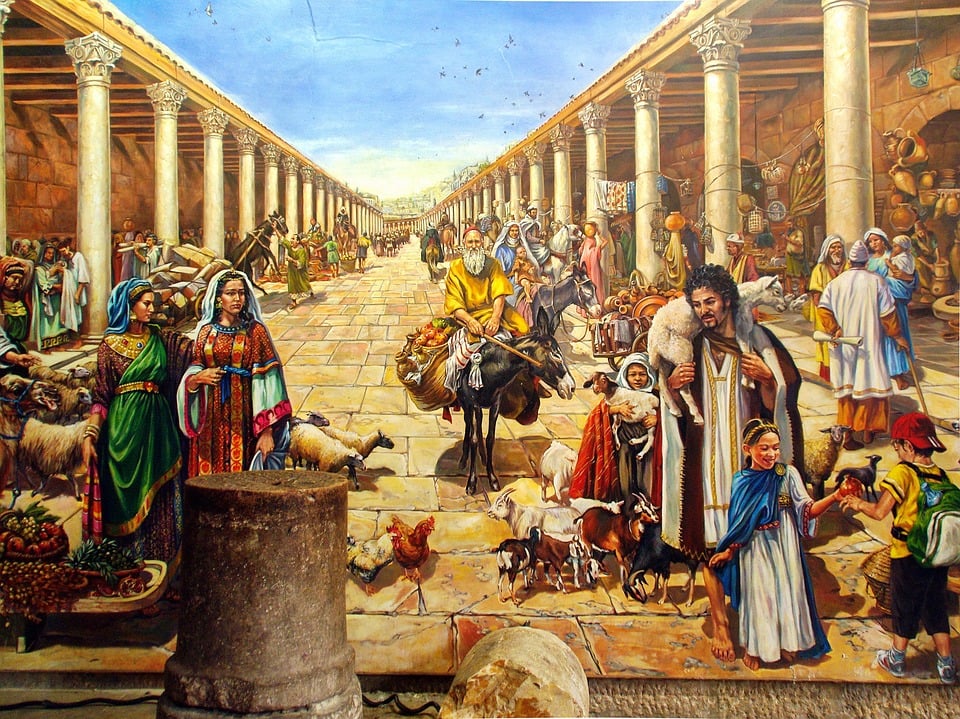The journey to Jerusalem stands as a pivotal narrative in the Gospel of Luke, spanning chapters 9:51 to 19:27. This passage captures Jesus’ determined path toward his ultimate destiny, offering profound insights into his teachings and interactions along the way.
As followers and readers delve into this section, they’ll encounter a blend of triumphs and trials that shape the essence of Jesus’ mission. The journey highlights his unwavering commitment and invites reflection on themes of sacrifice, faith, and resilience.

Through engaging stories and heartfelt moments, Luke paints a vivid picture of this transformative journey, making it a compelling subject for exploration and understanding.
Overview Of The Journey To Jerusalem
Jesus’ journey to Jerusalem marks a pivotal period in the Gospel of Luke, spanning chapters 9:51 to 19:27. This section highlights key events and teachings that shape His mission and legacy.
Context In The Gospel Of Luke

Luke’s account situates Jesus’ journey within a broader narrative of preparation and revelation. It begins with His resolute determination to reach Jerusalem despite growing opposition (Luke 9:51). The journey encompasses various teachings, miracles, and interactions with diverse groups, including disciples, Pharisees, and the broader public. Key events include the sending of the seventy-two apostles (Luke 10), the healing of the ten lepers (Luke 17:11-19), and the parable of the ten minas (Luke 19:11-27). These passages collectively illustrate Jesus’ strategies for discipleship, authority, and the unfolding of His divine mission.
Significance Of Luke 9:51-19:27
This segment underscores the transition from Jesus’ ministry of teaching and healing to the impending fulfillment of His purpose in Jerusalem. It highlights themes of faith, sacrifice, and the Kingdom of God. Notably, the parable of the ten minas emphasizes accountability and the responsible use of resources, while the encounter with the Samaritan leaders reveals the challenges of discipleship and leadership. Additionally, the narrative of Zacchaeus (Luke 19:1-10) exemplifies personal transformation and the reach of Jesus’ message. These elements collectively reinforce the theological and practical implications of Jesus’ journey, encouraging believers to emulate His commitment and resilience.
Key Themes And Messages
This section explores the central themes and messages presented in Jesus’ journey to Jerusalem, highlighting their significance and practical application.
Faith And Obedience
Faith underpins every step Jesus takes toward Jerusalem. His unwavering trust in God’s plan demonstrates true obedience, even when facing uncertainty. For instance, when Jesus sends out the seventy-two apostles, He empowers them with confidence, reinforcing the importance of trusting in divine guidance. Believers can learn to strengthen their faith by committing to God’s directives, even when the path ahead isn’t clear. Reflecting on Luke 9:51-19:27, it’s evident that obedience stems from a deep-seated faith that transcends immediate challenges.
Suffering And Sacrifice
Suffering and sacrifice emerge as pivotal elements in Jesus’ mission. His journey is marked by obstacles that test His resolve, embodying the ultimate sacrifice for humanity’s salvation. The healing of the ten lepers illustrates compassion amidst adversity, while the parable of the ten minas emphasizes responsibility and perseverance. These narratives encourage individuals to embrace their own struggles with grace, understanding that personal sacrifices contribute to a greater purpose. Jesus’ example teaches that enduring hardships can lead to profound spiritual growth and fulfillment of one’s calling.
Character Analysis
Adam Phillips, a seasoned youth pastor with over two decades of experience, delves deep into the profound narrative of Jesus’ journey to Jerusalem as depicted in Luke 9:51-19:27. This passage isn’t just a historical account; it’s a roadmap for modern believers navigating faith, sacrifice, and resilience.
Understanding the Path
Jesus’ determination to reach Jerusalem sets the stage for a transformative journey. It’s not merely a physical relocation but a spiritual expedition that challenges and shapes His disciples. Why is this journey pivotal? It highlights the unwavering commitment required to fulfill one’s mission, even when faced with opposition.
Key Events and Their Significance
- Sending the Seventy-Two Apostles
Jesus empowers His followers by entrusting them with missions. This act teaches the importance of delegation and trust within a community. When leaders distribute responsibilities, they foster growth and resilience among their team.
- Healing of the Ten Lepers
This miracle underscores compassion and gratitude. Only one returned to thank Jesus, emphasizing the value of recognition and personal responsibility in faith. It’s a reminder to acknowledge blessings and express gratitude, strengthening one’s spiritual journey.
- The Parable of the Ten Minas
Accountability and stewardship come to the forefront here. Jesus illustrates the importance of using one’s resources wisely and being accountable for one’s actions. This parable encourages believers to maximize their potential and contribute meaningfully to their communities.
Practical Lessons for Today
Faith in Action

Jesus’ journey teaches that faith isn’t passive. It’s about taking deliberate steps towards a greater purpose, even when the path isn’t clear. How can you apply this? Start by setting clear spiritual goals and take consistent actions towards them.
Embracing Sacrifice
Sacrifice is a recurring theme. Jesus’ willingness to face challenges for a higher cause inspires believers to prioritize their faith over personal gains. Consider what sacrifices you’re willing to make to strengthen your relationship with God.
Building Resilience Through Community
The interactions with various groups, including the Samaritan leaders, highlight the importance of community support. Surrounding yourself with a supportive faith community can bolster your resilience during tough times.
Step-by-Step Guide to Strengthening Your Faith
- Set Clear Intentions
Define what you aim to achieve in your spiritual journey. Clear intentions provide direction and purpose.
- Engage in Regular Reflection
Take time to reflect on your experiences and growth. Journaling can be a practical tool for this.
- Seek Accountability Partners
Connect with fellow believers who can support and challenge you. Accountability fosters growth and perseverance.
- Embrace Continuous Learning
Dive deeper into scripture and teachings. Continuous learning enriches your understanding and application of faith.
Inspirational Scriptures
- “Let your light shine before others, that they may see your good deeds and glorify your Father in heaven.” – Matthew 5:16
This encourages believers to live out their faith visibly and authentically.
- “I can do all things through Christ who strengthens me.” – Philippians 4:13
A powerful reminder of the strength available through faith.
Tips for a Resilient Faith Journey
- Stay Consistent in Prayer and Meditation
Regular spiritual practices build a strong foundation for resilience.
- Participate in Community Activities

Engaging with your faith community provides support and enhances your spiritual journey.
- Practice Gratitude Daily
Recognizing and appreciating blessings fosters a positive and resilient mindset.
Conclusion
Jesus’ journey to Jerusalem is more than a historical event; it’s a blueprint for navigating the complexities of faith, sacrifice, and resilience. By embracing the lessons from this passage, believers today can strengthen their spiritual walk and make meaningful contributions to their communities.
Major Events In The Passage
This section highlights key moments in Jesus’ journey to Jerusalem, showcasing His teachings and miracles that define His mission.
Entry Into Jerusalem
Jesus’ entry into Jerusalem marks a significant turning point in His mission. Riding on a donkey, He fulfills the prophecy of Zechariah 9:9, symbolizing peace. The crowd welcomes Him with palm branches and shouts of “Hosanna,” recognizing His authority. This event establishes Jesus’ role as the Messiah and sets the stage for the challenges He will face in Jerusalem.
Key Miracles And Teachings

Throughout this passage, Jesus performs several miracles and imparts essential teachings. He sends out the seventy-two apostles, empowering them to spread His message and heal the sick. The healing of the ten lepers demonstrates God’s mercy and the importance of gratitude, as only one returns to thank Him. Additionally, the parable of the ten minas highlights the value of stewardship and accountability in serving God’s kingdom. These events illustrate Jesus’ strategies for discipleship and His commitment to preparing His followers for the mission ahead.
Theological Implications
Jesus’ journey to Jerusalem underscores pivotal theological themes that shape Christian understanding. It highlights His unwavering commitment to fulfilling divine prophecy, emphasizing the necessity of sacrifice in His mission. By deliberately choosing the path of suffering, Jesus models ultimate obedience and sets the foundation for the concept of atonement.
The narrative illustrates the Kingdom of God’s nature, contrasting worldly power with divine authority. Jesus’ interactions reveal the inclusivity of God’s reign, welcoming diverse individuals while challenging societal norms. This inclusivity invites believers to embrace a broader, more compassionate community.
Faith and resilience emerge as central themes. The disciples witness firsthand the trials Jesus faces, reinforcing the importance of steadfast trust in God’s plan. This journey teaches that true faith perseveres through adversity, encouraging believers to remain committed despite challenges.
Moreover, the fulfillment of Old Testament prophecies during this journey reinforces the continuity and reliability of Scripture. Prophecies such as Zechariah 9:9 are manifested, affirming Jesus as the Messiah and validating the theological framework of the New Testament.

Stewardship and discipleship are also prominent. Jesus delegates responsibilities to His followers, illustrating effective leadership and the importance of empowering others. This approach fosters a sense of accountability and active participation in the divine mission, urging believers to engage meaningfully in their faith communities.
Finally, the journey emphasizes the redemptive purpose of suffering. Jesus’ path to Jerusalem is marked by acts of love and sacrifice, offering a model for believers to navigate their own struggles with grace. This redemptive suffering serves as a cornerstone for understanding salvation and the transformative power of enduring hardships for a greater good.
Conclusion
Jesus’ path to Jerusalem reveals a profound journey of faith and resilience. It highlights the strength found in community and the power of unwavering commitment to a higher purpose.
As believers reflect on these events, they’re inspired to embrace sacrifice and trust in their own spiritual journeys. The lessons of delegation and stewardship encourage active participation in their communities, fostering growth and accountability.
Ultimately, this journey serves as a timeless guide, reminding everyone that true faith shines brightest through challenges. By embodying these principles, individuals can navigate their own paths with grace and contribute meaningfully to the world around them.












